I wrote this summary for English 100 on an article about the importance of urban forests.
“The importance of urban forests: why money really does grow on trees” is an expository article by Amy Fleming that investigates the true value of nature by comparing the relationship between trees and the economy. Her article uses evidence from different research studies to explore how rural living can be socially and economically beneficial. “Trees” supply “ecological services” that are practically unheard of: they decrease “air conditioning” and heat usage and lower city temperatures (Fleming 2). They can also “cool cities between 2C and 8C” and “increase the value of property by 20%” (Fleming 2). Fleming states that the natural benefits of trees encourage energy-saving, so “money… does grow on trees,” as they literally reduce energy costs (Fleming 1). Multiple studies in Fleming’s article outline the economic advantages of nature. For example, when measuring trees’ impact on the economy, the New York City park department found that “[t]here were $28m worth of energy savings, $5m worth of air quality improvements and $36m of costs avoided in mitigating storm water flooding” (Fleming 3). This information is relevant, as it is important for today’s readers to recognize how much we rely on earth. Trees prove to be equally beneficial for personal well-being. People living in forested areas demonstrate non-violent behaviour compared to habitants of busier regions (Fleming 4). Fleming points out how our living environment plays a significant role in mental health. Trees can affect health mentally just as it can physically. Public health expert William Bird explains that residents of higher tree volume districts experience more physical and social activity, and they experience less depressive thoughts and anxious feelings (Fleming 4). Fleming includes evidence-based research studies to highlight the social and economic benefits of living amongst trees and nature.
